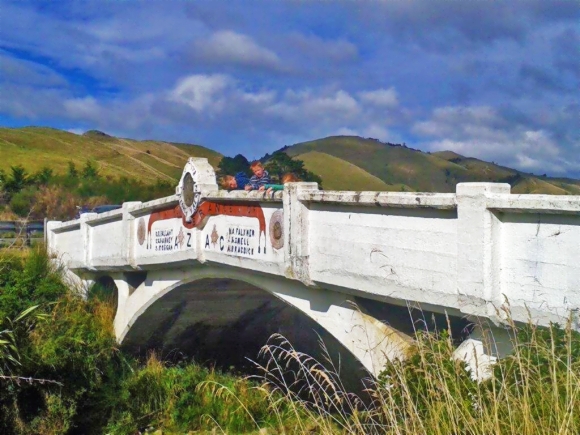We also read out this lovely message from the Brooweena community to the people of Kaiparoro. This is what it said:
Dear Friends of the Kaiparoro Bridge,
Today is a day on which we remember all New Zealand and
Australians who served and died in war and on operational service. The Spirit of ANZAC with its qualities of
courage, mateship and sacrifice continues to have meaning and relevance for our
sense of national identities.
Mateship continues with this link between our two unique Bridges
in a bond that was forged on this day so long ago. We remember those who served our countries
and reflect upon their selfless sacrifice and also acknowledge the losses and
sacrifices of their families.
Our bridge, of wooden construction with concrete piers, though
not so grand as yours, is the only privately erected War Memorial in
Queensland.
It is situated 19 km south of Brooweena, a very small
township in South East Queensland. It
was designed by Laurence Stevens Smith then the owner of historic “ Mount
Joseph Station” which is situated opposite. It was constructed by Frank Fallon along with Station hands from Mount
Joseph and a number of returned servicemen from the district. It was officially opened on 21 May,
1921. The Fallen of WW1, 9 local men, are listed on one pier and directly opposite
are the names of the Returned Soldiers. It is uncanny that the number should be the same as your bridge and that
both bridges were constructed with the help of the Returned.
The bridge carried traffic on the Woolooga Road for over
fifty years, ceasing on 16 June 1972 with the completion of a new adjacent
road. Restoration works were carried out
in 2008 by the staff of the Woocoo Shire Council together with invaluable input
from several local residents.
Today the bridge is cared for by the “Friends of the Bridge”
in conjunction with the Fraser Coast Regional Council. Each year since 2009 on Anzac Day we hold an
informal service followed by a picnic lunch. We remember our fallen and
returned, children recite poetry, we tell stories in relation to our
fallen, raise our flag with pride, lay
wreaths to the eerie sound of bagpipes by our lone piper, and give thanks for
the freedom we enjoy.
The Anzac spirit exists in each of us so therefore let us be
guided by that ANZAC spirit in facing national and personal challenges ahead
and let us strive to be worthy of the memory of those we honour today!
We will include the names of your fallen in our Service and
remember the friendship between your country and ours and the link that has now
been “bridged”. We look forward to
strengthening that bond and continued correspondence in the future!
God Bless
Best Wishes
From the Brooweena
District and “Friends of the Bridge”















































